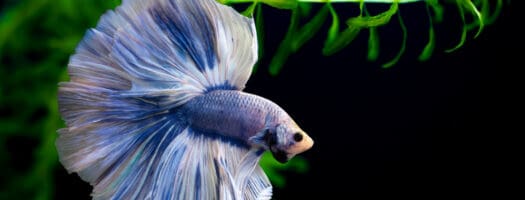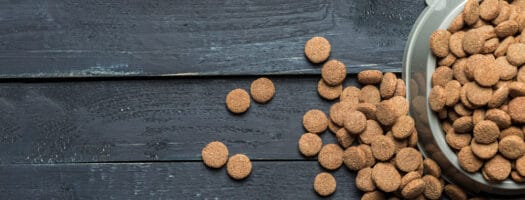The 10 Best Floating Aquarium Plants to Buy in 2025
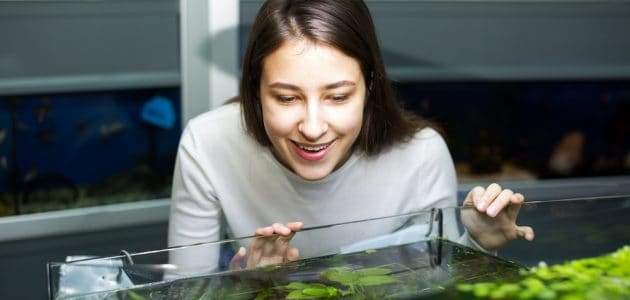
An aquarium without floating plants is a lot like a sky without clouds, and just like humans, fish can tell that something is missing. If you’re wondering if your aquatic family would enjoy an overhead of greenery, start small and watch their renewed quality of life speak for itself.
Floating aquarium plants transform freshwater tanks into rich environments where aquatic life can flourish. No matter the type of aquarium you own, there’s a floating plant out there that can boost its aesthetic — amongst many other things!
- How to Pick the Best Floating Plants for Your Aquarium
- Top 10 Best Floating Aquarium Plants 2025
- 1. Best Overall Floating Aquarium Plant: Water Spangles
- 2. Best Premium Floating Aquarium Plant: Amazon Frogbit
- 3. Best Artificial Floating Aquarium Plant: Water Lily Pads
- 4. Best Floating Aquarium Plant for Snails: Giant Hairgrass
- 5. Best Flowering Floating Aquarium Plant: Dwarf Water Lettuce
- 6. Most Affordable Artificial Floating Aquarium Plant: Lotus Leaf
- 7. Best Floating Aquarium Plant for Open Tanks: Red Root Floater
- 8. Most Adaptable Floating Aquarium Plant: Java Moss
- 9. Best Budget Floating Aquarium Plant: Duckweed
- 10. Best Versatile Floating Aquarium Plant: Brazilian Pennywort
- A Guide to Buying the Best Floating Aquarium Plants
- Final Thoughts
How to Pick the Best Floating Plants for Your Aquarium
A lot of love and dedication goes into setting up a successful fish tank. Adding or subtracting one factor can quickly change the composition of an ecosystem. However, that’s not always a bad thing. When you find the best floating aquarium plants for your tank, your aquatic pets quickly reap the benefits.
Benefits of Floating Aquarium Plants
Before we reveal our favorite plants, we want to take a moment to discuss the many benefits that adding floating plants to your aquarium can bring.
Aesthetic
Adding floating aquarium plants to your fish tank does wonders for its visual appeal. You’ll love the natural look it brings to your tank, but your fish will love it even more.
Filtration and Waste Regulation
When dealing with nano fish tanks, floating aquarium plants can double as a filtration system. But while they do a lot to filter water, most fish tanks still require a mechanical filtration system. Floating aquarium plants quickly regulate waste while reducing nitrate and phosphate levels.
Oxygenation
The presence of floating aquarium plants improve the health of your fish by supplying their tank with extra oxygen.
Food
Floating aquarium plants can also serve as a nutritious snack. Your fish will be able to graze and nibble this vegetation, adding vitamins and nutrients to their diets. However, do note that plants do not replace the need for actual fish food.
Shade
Some aquatic creatures enjoy plenty of shade while others are content with minimal amounts. In general, fish enjoy swimming under shaded waters because it makes them feel safe and protected. A shaded haven can transform a timid fish into a curious one. However, an excess amount of cover-surface can lead to disturbance in your lower tank, as discussed in our full guide.
Recreation
When you’re a fish living in a tank, you need all the recreational activity you can get. Adding floating aquarium plants to your tank can create a fun environment for fish to hide and play in.
Breeding
If you’re looking to grow your aquatic family, breeding might be on the table. Should this be the case, floating aquarium plants are the perfect place for fish and shrimp to lay their eggs and an even better place for their offspring to play in. This also applies to betta fish, too — who utilize floating aquarium plants when building bubble nests.
Can I Use Plastic Floating Aquarium Plants in My Tank?
Live aquarium plants tend to be the preferred option, however, fake aquarium plants are far from shabby. In fact, it’s perfectly common for fish owners to use a combination of live and fake floating plants in their tanks. While different, plastic plants do offer plenty of benefits, albeit some cons as well.
If you are strictly here for plastic floating aquarium plants, we have two artificial options on our list: Lotus Leaves and Water Lily Pads. Feel free to jump ahead, as most of the information in this guide is tailored to live floating aquarium plants.
What to Consider When Selecting the Best Floating Aquarium Plants?
We took the following factors into consideration when building our list of the best floating aquarium plants of 2025. We’ll highlight these categories as we dive into each entry — so you know exactly what you’re working with.
- Type: We’ll let you know what you’re looking at: A live plant or an artificial one.
- Growth: We’ll fill you in on each plant’s growth cycle, to help you find one that suits your aquatic schedule.
- Temperature: We’ll explain which temperatures need to be maintained to keep each plant happy and healthy.
- Upkeep: Lastly, we’ll label each plant as low, medium or high-maintenance.
Now that we know why floating aquatic plants are so great, let’s find out which plants made the A-list. Should you need any more information, we welcome you to check out our full Buyer’s Guide, where you can find answers to frequently asked questions and more.
Top 10 Best Floating Aquarium Plants 2025
1. Best Overall Floating Aquarium Plant: Water Spangles
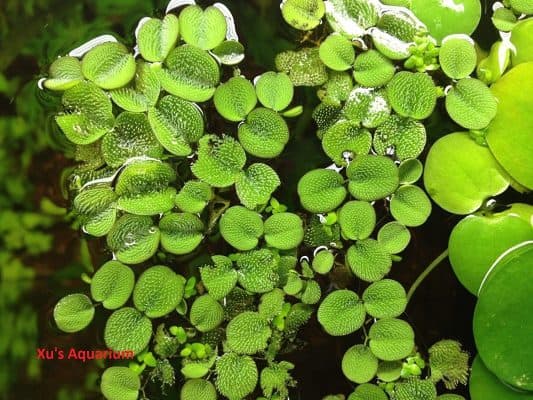
Editor’s Rating:
Why we like it: Nothing brings the surface of a fish tank alive like the beautiful sight of Water Spangles. Caring for these plants isn’t a huge commitment but, since they propagate quickly, they do require some extra attention. Your fish will love nibbling on these floating aquarium plants!
Quick Facts
- Type: Live
- Growth: High growth rate
- Temperature: 65°- 89 °F
Upkeep
Water Spangles are low to medium maintenance. They require moderate to high levels of light to thrive. They also prefer to survive in a tank with low water flow.
Review
Water Spangles (Salvinia Minima) are one of the easiest floating aquarium plants to take care of as they don’t require any substrate. Still, that doesn’t mean that you can let this plant fend for itself. After all, it does grow at an alarming pace, and can quickly take over the surface of your tank, preventing light from getting through.
To stop this from happening, you can make a floating plant separator out of tubing. These plants are versatile and, as long as their required temperatures are respected, they can survive in an outdoor pond, a small beta tank or a large aquarium.
The majority of fish, excluding most goldfish and tropical fish, enjoy nibbling on Water Spangles. These plants are safe for small aquatic creatures like snails or shrimp, too. We chose to give Water Spangles a rating of 5 stars because they’re such a joy to own and truly benefit tanks by adding shade and boosting oxygenation.
However, it’s important to note that since these plants grow quickly, it’s crucial that you control their growth to prevent them from taking over your fish tank. Additionally, they will require a special light if you choose to keep them indoors.
Pros
- Propagates quickly
- Can survive in low water flow
- Good snack for fish
- No substrate needed
Cons
- Can quickly block out light
- Requires moderate to high lighting
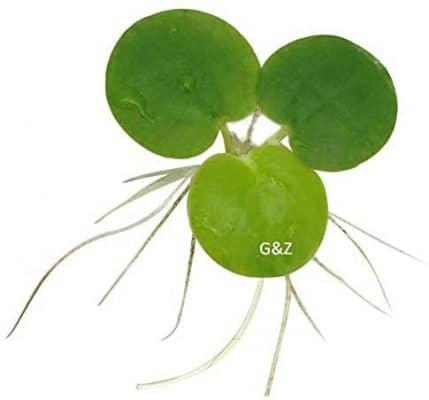
Editor’s Rating:
Why we like it: We love how Amazon Frogbits have long roots that little fish love to hide, play and breed in. These floating plants give our aquatic friends plenty of shade and comfort. Plus, they’re super easy to take care of and transform everyday tanks into gorgeous waterscapes.
Quick Facts
- Type: Live
- Growth: High growth rate
- Temperature: 68°- 86°F
Upkeep
Amazon Frogbits are low maintenance and can thrive in many different environments. They require a good amount of light to propagate and do best in aquariums with a low to medium water flow. In a perfect world, Amazon Frogbits would receive up to 12 hours of sunlight a day. However, if the given light is too hot, it can cause this plant to burn up.
Review
Amazon Frogbit (Limnobium Laevigatum) is one of the most popular floating aquarium plants, and for good reason, too. These aquatic plants are loved by betta fish since they produce plenty of shade. They have long roots that can be snacked on by fish, too. However, if you have large fish in your tank, they may eat and pull at the roots, causing the plant’s health to falter.
Amazon Frogbits grow quickly and do not need any substrate to survive. Better yet, they cleanse water by removing unhealthy nutrients, making them a star in our books.
Despite their high growth rate, Amazon Frogbits are relatively low maintenance. But just like Water Spangles, they can quickly take over the surface of your tank, so it’s important to keep an eye on them.
A few things to keep in mind. First, since Amazon Frogbits have very long roots that can get stuck in your tank’s filter. To prevent this from happening, use angling wire to secure the roots away from the filter.
Secondly, Amazon Frogbits are loved by betta fish, clownfish and gourami alike, but when it comes to snails, some might say that they like this plant a little too much. They will nibble at its underbelly until the plant dies, which is something to consider.
Pros
- Grows quickly
- No substrate needed
- Roots can be snacked on by fish
- Removes unhealthy nutrients from water
Cons
- Roots may get caught in the filter
- Requires moderate to high lighting
- Not compatible with snails
3. Best Artificial Floating Aquarium Plant: Water Lily Pads
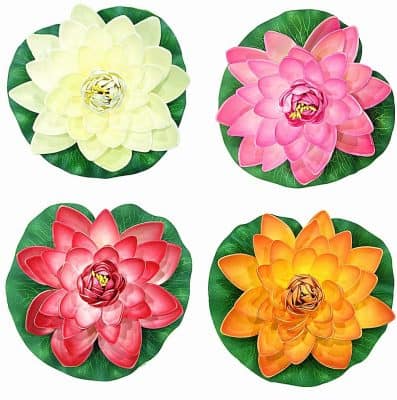
Editor’s Rating:
Why we like it: These Water Lily Pads do the trick — whether you want to add a pop of color to your pond or give your pet frog a comfortable place to rest his head. They can be combined with live aquarium plants for a pleasing aesthetic look.
Quick Facts
- Type: Artificial
- Growth: N/A
- Temperature: N/A
Upkeep
Artificial Water Lily Pads are very low maintenance. However, if they begin to attract microorganisms, it’s important to wash them. You can cleanse them by soaking them in a bucket of 80% water and 20% outdoor Clorox — just be sure to give them a proper rinse before placing them back into a body of water.
Review
When you order a pack of Water Lily Pads, you receive 4 artificial plants with brightly-colored flowers. If you wish to anchor them in place you can add a weight to the hook that is attached to the underbelly of each flower. These faux Water Lily Pads can be placed in pools, koi ponds and fish tanks. They’re loved by frogs, newts, betta fish and many other species, as they provide a lot of shade while doubling as the perfect hang-out spot.
Although many fish owners prefer to add live plants to their aquariums, plastic Water Lily Pads can work with live plants to create a pleasing aesthetic look. They retain their vibrancy for years on end. However, do note if they are subjected to harsh sunlight their colors will eventually fade. As you might expect, they add no ecological value to waterscapes either. On the bright side, if they were real, then your fish might try and eat them – which would be a bummer, considering how beautiful they are.
If you’re looking for an artificial floating plant that is a bit more demure in appearance, we recommend looking into the faux Lotus Leaf instead.
Pros
- Realistic look that offers a pop of color
- Provides a nice chilling spot for frogs, newts and betta fish
- Provides shade
- Long-lasting
Cons
- Sunlight can cause their vibrancy to fade over time
- Do not have any ecological value
4. Best Floating Aquarium Plant for Snails: Giant Hairgrass

Editor’s Rating:
Why we like it: How do you get your fish tank to look like a natural habitat? You add some Giant Hairgrass to its substrate — that’s how. Giant Hairgrass gives aquariums a look of serenity, and small fish and invertebrates can’t get enough of it.
Quick Facts
- Type: Live
- Growth: Giant Hairgrass grows very tall very quickly, which is why you will often need to trim the excess growth.
- Temperature: 73°- 83°F
Upkeep
In order to thrive, Giant Hairgrass requires about 10 hours of light a day. They are a relatively low maintenance floating plant, that can be potted directly into your substrate.
Review
Giant Hairgrass (Eleocharis Montevidensis) is a low maintenance background plant that brings aquariums to life with ease and style. Few floating plants can create a backdrop like the Giant Hairgrass can. This plant is popular because it has the ability to mask unattractive tank features — like wires and filters.
Despite the fact that Giant Hairgrass requires a decent amount of light and occasional trimmings, it is considered to be a low maintenance aquarium plant. If you have snails in your tank that are constantly eating your live plants, Giant Hairgrass is a good option, as it is harder for them to feast on.
It’s not perfect however. First of all, this plant is very thin and, although it grows quickly, it grows in length and not in thickness. So, if you plan on decorating your tank with Giant Hairgrass, you need to order a quite a lot to fill your tank’s backdrop. Secondly, Giant Hairgrass can easily be uprooted by larger fish who have a bone to pick with it.
Pros
- Beautiful look
- Compatible with snails
- Hides unattractive tank features
Cons
- Very thin
- Can be uprooted by strong fish
5. Best Flowering Floating Aquarium Plant: Dwarf Water Lettuce
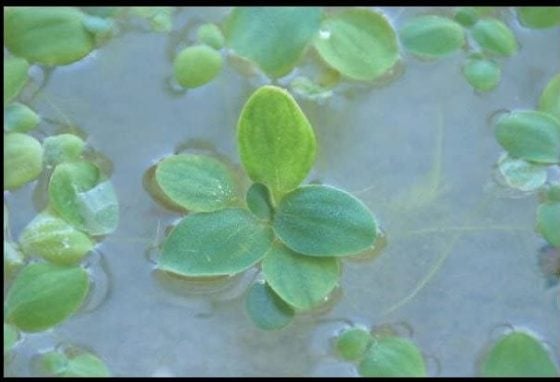
Editor’s Rating:
Why we like it: Although a little more expensive than other floating aquarium plants, Water Lettuce is a gorgeous plant that makes any aquarium look stunning. We love how they produce small flowers in the late summer months to give you the sense of an evolving waterscape.
Quick Facts
- Type: Live
- Growth: Water Lettuce is one of the fastest-growing floating aquarium plants. To prevent it from overtaking your tank, use an angling wire to bind it to one section or your aquarium.
- Temperature: 15°- 86° F
Upkeep
Due to how quickly this plant grows, a medium amount of upkeep is required. To keep this plant healthy and happy, be sure to remove any yellowing or dead leaves from its surface, leaving behind the healthy green growths.
Review
Water Lettuce is one of the most beautiful floating plants on the market. It produces small white flowers near the end of summer and early fall. Much like the Amazon Frogbit plant, Water Lettuce is known for its long roots, which provide adequate shelter for small fish. However, since they grow at an alarming pace, it’s best to keep them out of small aquariums, as they can quickly take over the surface, snuffing out all sunlight.
Although Water Lettuce does require a good amount of light to thrive, it also requires some shade, especially in scorching climates. It’s also very important to note that water lettuce contains a poisonous compound called calcium oxalate, which, if ingested by animals, children or adults, can lead to kidney damage as well as a burning sensation in the mouth. For this reason, it’s best to add Water Lettuce to large aquariums or ponds where animals and children are unlikely to happen by.
All things considered, Water Lettuce is a beautiful floating aquarium plant that offers lushness to all waterscapes. If its toxicity levels turn you away, we recommend looking into the Amazon Frogbit floating plant instead.
Pros
- Gorgeous look
- Produces small flowers
- Long roots provide shelter for small fish
Cons
- Not ideal for small tanks
- A little pricey
- Toxic to animals and children if ingested
6. Most Affordable Artificial Floating Aquarium Plant: Lotus Leaf
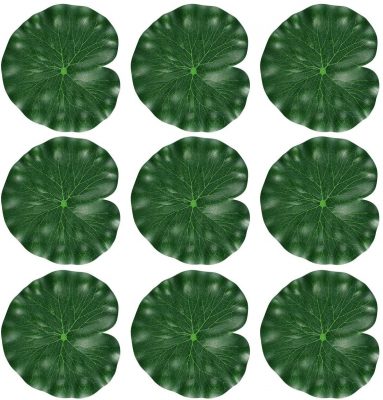
Editor’s Rating:
Why we like it: We love how artificial Lotus Leaves attract young frogs and tadpoles to their surfaces, allowing them to lounge in the sun. These Lotus Leaves are super affordable, easy to clean and very realistic. They add a dash of beauty to every pool, aquarium or pond.
Quick Facts
- Type: Artificial
- Growth: N/A
- Temperature: N/A
Upkeep
Artificial Lotus Leaves require very little upkeep. However, it’s important to note that you should still soak them and thoroughly rinse them before adding them to a body of water. Repeat this after a while should they start looking grimy.
Review
When you order a pack of Lotus Leaves, you receive 10 vibrant lotus leaves that look so realistic your friends will have a hard time believing that they’re fake. These fake floating plants are gorgeous and add an aesthetic look to your pool, pond, aquarium or fish tank. Although they do not provide any organic substance, they do give off plenty of shade and will quickly become a chilling spot for smaller frogs and tadpoles. However, it’s important to note that larger frogs might be too heavy for these Lotus Leaves, causing them to sink.
We’d also like to point out that, unlike the artificial Lily Pads, these faux floating aquarium plants do not have a hook to attach weights to. This can be disappointing, especially since they’re so light they can be blown out of the water by a strong breeze. To prevent this from happening, you can tie them together with a fishline and anchor them down.
Pros
- Affordable
- Visually appealing
- Realistic
- Provide shade
Cons
- Must be anchored by fishing line if used outdoors
- May sink under the weight of a large frog
7. Best Floating Aquarium Plant for Open Tanks: Red Root Floater
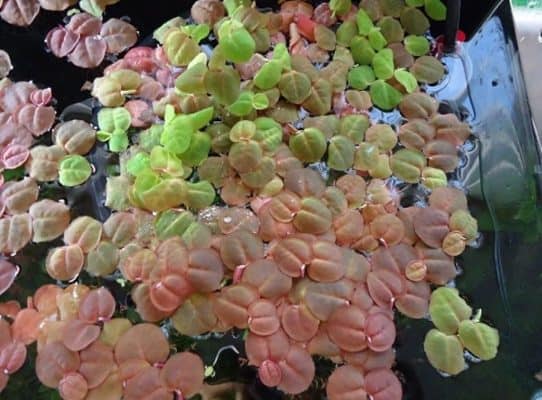
Editor’s Rating:
Why we like it: Red Root Floaters are one of a kind: they add a pop of red where blue and green usually dominate, making your tank stand out. We love how quickly they grow and how, if you treat them right, little flowers will soon appear.
Quick Facts
- Type: Live
- Growth: Red Root Floaters grow at a steady pace.
- Temperature: 70°- 82°F
Upkeep
Red Root Floaters do best when showered with plenty of light, causing their leaves to turn bright red. They are relatively low maintenance but do require a gentle water flow to thrive. Should the Red Root Floater plant receive low amounts of lighting, it will turn green but will continue to live.
Review
The Red Root Floater (Phyllanthus Fluitans) is unlike any other floating aquarium plant, and this is because of its vibrant red color. Better yet, if in optimal living conditions, small white flowers will bloom at its center. These plants have long red roots that small fish can hide and play in, turning timid fish into explorers. They provide plenty of oxygen and shade and are very easy to care for.
The Red Root Floater is a great addition to any tank, but you’ll notice that it’s a bit more expensive than other low-maintenance options. It is also important to note that this plant thrives in open tanks opposed to closed ones. Red Root Floaters have long roots that can get caught in filters but using an angling wire to tame its roots can prevent this from happening.
If you’re looking for a pop of color but don’t want to commit to taking care of a live plant, you may want to check out the artificial Water Lily Pads, as maintaining them is virtually non-existent and they never fail to decorate a waterscape.
Pros
- Beautiful red color
- Provides plenty of oxygen
- Provides shade
- Produces small flowers
Cons
- A little pricey
- Better suited for open tanks
- Long roots can get caught in the filter
8. Most Adaptable Floating Aquarium Plant: Java Moss
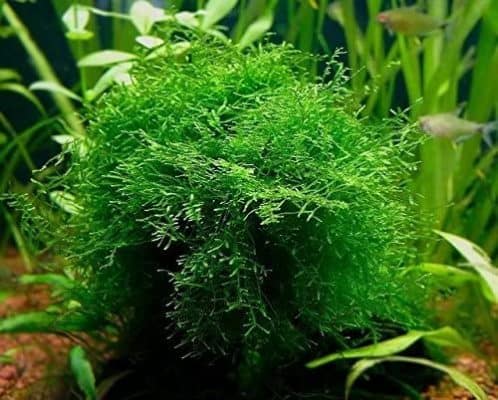
Editor’s Rating:
Why we like it: Java Moss is one of the most resilient and sturdy floating plants on the market, and it’s versatile, too. It can thrive either at the top of your tank or be anchored down to the bottom. It’s the perfect plant for breeding and bubble nests.
Quick Facts
- Type: Live
- Growth: Java Mass grows at a slow to medium pace.
- Temperature: 59°- 82° F
Upkeep
Java Moss is so versatile, it can be left to its own devices and still manage to thrive. To say it is low maintenance would be an understatement. To keep your Java Moss as healthy as can be, periodically feed it some liquid fertilizer. Also, it prefers to be subjected to low levels of light.
Review
Java Moss (Taxiphyllum Barbieri) is adaptable beyond belief and its appearance can sometimes deceive you. When you first receive your Java Moss, you might notice that it is brown and unhealthy-looking. Don’t worry, once rinsed and placed into an aquarium, it will quickly ditch its brown color and become a vibrant green.
Java Moss will happily float on the surface of your aquarium or hunker down near the substrate. It goes with the flow, so to speak. When placed at the bottom, Java Moss becomes the perfect place for fish to lay their eggs, and it also doubles as a hiding spot for younger and smaller fish.
Java Moss will happily survive in any aquarium, no matter its size. However, it’s important to note that if you have shrimp, your Java Moss might disappear before your eyes — it’s just that tasty. Despite being low maintenance, it does best in indoor aquariums where you can control the level of light it receives. If you’re looking for a floating aquarium plant that your shrimp won’t eat, we recommended looking into Water Spangles instead.
Pros
- Very adaptable
- Compatible with all aquarium sizes
- Can be left floating or be attached to a surface
- Perfect for breeding
Cons
- Shrimp will devour these plants
- Requires low levels of light
9. Best Budget Floating Aquarium Plant: Duckweed
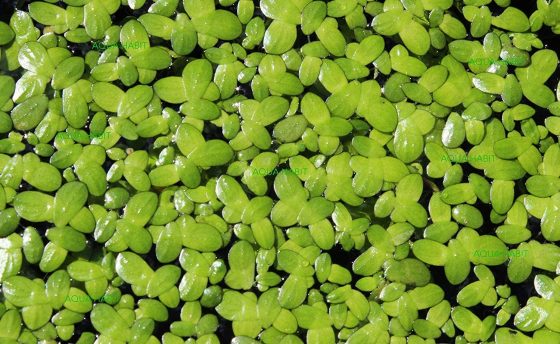
Editor’s Rating:
Why we like it: You don’t need to have a green thumb to welcome Duckweed into your home. Duckweed is one of the most inexpensive floating aquarium plants, and it grows super-fast. Let’s just say, you’ll get a lot for what you pay for.
Quick Facts
- Type: Live
- Growth: Duckweed is one of the fastest-growing floating plants. When in optimal conditions, it can double every two weeks or so.
- Temperature: 42°- 92°F
Upkeep
Although Duckweed is considered to be a low maintenance plant, it grows so quickly that it can take over a pond, aquarium or tank in just a few weeks. For this reason, it’s important to use a floating plant separator to limit its spread. Duckweed requires a medium to high level of light, although it can survive in low lighting, too.
Review
Duckweed (Lemnaceae) is one of the most popular floating aquarium plants due to how easy it is to keep it happy. This plant has a very high protein content and is one of the most nutritious plants, especially for goldfish, koi fish, ducks and turtles. They all love to chow down on this floating plant. It offers plenty of benefits to your aquarium, too, like the fact that it naturally controls the growth of algae.
All good things aside, there are a few things about Duckweed that isn’t ideal, like the fact that it grows so fast means it can be hard to keep up with. As a result, it has a tendency of clogging filters. If you have aquatic animals who regularly eat this plant, neither of these things will be an issue. But, if you don’t, you might find it hard to manage.
Additionally, these plants have very small leaves, which is why frogs don’t love them. If you choose to side with Duckweed but have a pond with frogs in it, you might want to add a few artificial Lotus Leaves to keep them afloat.
Pros
- High in protein
- Inexpensive
- Perfect for goldfish, koi fish, ducks and turtles
- Controls the growth of algae
Cons
- Very small leaves
- Grows at an alarming rate
- Can get caught in filters
10. Best Versatile Floating Aquarium Plant: Brazilian Pennywort
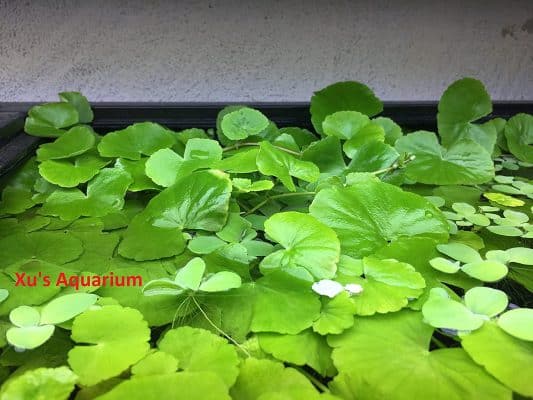
Editor’s Rating:
Why we like it: We love the unique look the Brazilian Pennywort has to offer and how quickly it spreads its gorgeous leaves. This plant provides plenty of shade, allowing your fish to feel safe and sound.
Quick Facts
- Type: Live
- Growth: Brazilian Pennyworts are very fast growers that can quickly take over the surface of a body of water, which is why limiting its outreach can be beneficial.
- Temperature: 68°- 82°F
Upkeep
We would consider Brazilian Pennyworts to be a medium maintenance plant. Although they nearly raise themselves, they can take over an aquarium in the blink of an eye if left to their own devices. This plant is very versatile and can survive without much light. However, it will do best when subjected to medium light.
Review
Just like Java Moss, the Brazilian Pennywort (Hydrocotyle Leucocephala) can be planted into the substrate of an aquarium or be left floating at the top. This versatile floating plant has a unique look that can add richness to any body of water, without breaking the bank. It provides plenty of shade and shelter for smaller fish who like to keep a low profile.
Despite its easy growth, we wouldn’t call the Brazilian Pennywort a low maintenance plant, and this is because it must be regularly trimmed to prevent it from taking over the surface area of your aquarium. This floating plant grows just as quickly as Duckweed, which is why it can be a good idea to keep these two plants away from each other. To prevent it from clogging your filter, you can limit its growth by using a floating plant separator.
Pros
- Versatile
- Unique look
- Provides shade and shelter
Cons
- Can quickly overrun an aquarium
- Can get caught in filters
- Requires medium maintenance
A Guide to Buying the Best Floating Aquarium Plants
Fish owners all over the world know that running a successful aquarium is no walk in the park. There is so much to consider when adding a new specimen to your tank, be it a fish, a snail or a floating aquarium plant. However, when done right, your aquascape can flourish, improving the quality of life of your underwater family. Before we answer some of the most frequently asked questions concerning floating plants, let’s cover everything you need to know before making a choice.

What to Consider Before Selecting the Best Floating Aquarium Plants
Before you can pinpoint the best floating aquarium plant for your tank or pond, it’s crucial that you consider some very important factors. This will help you choose a floating plant that will benefit your tank and the aquatic creatures that call it home.
Size
Most floating plants can thrive in just about any aquarium, no matter its size. However, there are a few plants that require a larger environment to thrive in, like Water Lettuce, for example.
Seller Reputation
When you order a floating aquarium plant online, it’s important to find a reputable seller who can offer you quality products. No matter their reputation though, it’s important to thoroughly wash the plant and give it some downtime before introducing it into your tank. All of the sellers on our list are touted for quality and excellent customer service.
Lighting
If you plan on adding a floating plant to an outdoor body of water, you don’t have to worry too much about lighting, the sun will do that for you. However, if you plan on introducing a floating plant to your indoor aquarium, finding out how much light a plant needs to thrive is of utmost importance.
Aquatic Life
Most importantly, you need to consider if the chosen floating plant is going to improve the life of the aquatic creatures living in your tank.
Filtration System
Although floating aquarium plants do help with oxygenation and filtration, larger tanks will still require a reliable filtration system. However, if you have a small fish tank you can swap a filter for a floating plant like Duckweed. This plant improves the levels of oxygen while working to reduce the growth of algae. But beware, it grows very quickly and requires maintenance.
Surface Agitation
Another important factor to consider is the surface agitation of your aquarium or pond. Most floating plants prefer to live amongst a low water flow, as is the case with Water Spangles.
Fertilizer
Although not all floating aquarium plants require fertilizer to survive, adding some to your substrate can help your plants thrive. Such is the case for the ultra-adaptable Java Moss.
Long-Term Goals
Before adding a floating plant to your aquarium, it can be beneficial to decipher what your long-term goals are. Are you searching for a plant that will live in your tank for years on end, helping to improve everything from cleanliness to oxygenation? Or are you simply looking to add a dash of color to your aquascape? If the latter statement is accurate, we suggest looking into an artificial plant like the Water Lily Pad.
The Difference Between Live and Artificial Plants
Floating aquarium plants have so many benefits, it’s a wonder that anyone could have a plantless aquarium. However, without proper care, they can be tough to maintain. Artificial plants are superior in this regard. Let’s go over the benefits and drawbacks of each.
Pros of Live Aquarium Floating Plants
- Natural filtration
- Improves oxygen levels
- Provides hiding spots
- Encourages fish to play and breed
- Natural food supply
- Controls the levels of algae
- Beautiful
Cons of Live Aquarium Floating Plants
- Maintenance
- Live plants with long roots can clog tank filters
- Most live plants require a low water flow
- Overgrowth can limit the amount of light in your tank
- If not properly cleaned, they can bring parasites into your tank
- Create an abundance of CO2 during the night
One way to prevent any of these cons from taking place is to choose a very low maintenance and adaptable plant like the beloved Java Moss.
On the other hand, live floating aquarium plants are great but they’re not for everyone. Sometimes, it can be beneficial to opt for an artificial floating plant instead, especially if you don’t have much time to dedicate to maintenance. Let’s look at the pros and cons.
Pros of Artificial Floating Aquarium Plants
- Little to no maintenance is required
- Will not change the composition of your aquarium
- Do not harbor parasites
- Easy to clean and remove
- Can boost an aquarium’s overall look
Cons of Artificial Floating Aquarium Plants
- Colors can fade over time
- Generally more expensive than real floating plants
- Doesn’t add any value to the ecosystem
- Must be thoroughly cleaned before being added to the tank
Both live and artificial plants can improve the life of your aquatic pets. So ultimately, the choice is yours.
Frequently Asked Questions (FAQs)
Now that we’re familiar with both sides of the coin, let’s cover some of the most frequently asked questions concerning floating aquarium plants.
Do I Need a Floating Plant Separator?
Whether or not you need a floating plant separator is entirely up to you. However, if you have more than one plant species living in your tank, you might want to split things up. This is especially important if you have a floating plant that grows as quickly as Duckweed, as you might need to isolate an encumbered area so that light can get through to the bottom of your tank. You can create a floating plant separator by using Airline Tubing.
How Many Floating Plants Can I Have in My Fish Tank?
While there is no limit to the number of plants you can add to your fish tank, there is such a thing as too many. Since most plants absorb and give off oxygen, having too many plants can affect your fish in a negative way. When selecting plants, be sure that they work together to create a healthy environment for your pets. Using floating plant separators can also help prevent the takeover of certain fast-growing plants.
What Is Substrate?
Substrate is a term used to refer to the loose materials at the bottom of your tank. Substrate can be anything from pebbles and gravel to sand and soil.
Can I Put Floating Plants in My Pond?
There are plenty of floating aquarium plants that can thrive in an outdoor or indoor pond. One of the most commonly used floating plants is Duckweed. If you have ducks, goldish, turtles or koi fish, they will love snacking on these tasty plants and luckily, Duckweed is so bountiful, they’ll be able to eat at leisure.
Are Floating Aquarium Plants High Maintenance?
While some floating aquarium plants are high maintenance, most of them pretty much fend for themselves. This is the case for the majority of the floating plants on our list. However, plants that grow at an alarming pace may require additional work, as leaving them to their own devices can cause them to take over your aquarium. If you’re looking for a gorgeous floating plant that has long roots but is considered to be very low maintenance, we suggest checking out the Red Root Floater.
Which Floating Aquarium Plant Is Best for Shrimp?
If you’re thinking of adding a floating aquarium plant to your shrimp tank, we would highly suggest Water Spangles.
Which Floating Aquarium Plant Is Best for Betta Fish?
When it comes to floating aquarium plants, betta fish aren’t too picky. In fact, they’re happy as long as the chosen plants offer them plenty of shade and downtime. However, when it comes to building their bubble nests, betta fish tend to prefer utilizing the ultra-adaptable Java Moss. This is especially true when Java Moss has been set up to float instead of anchored down.
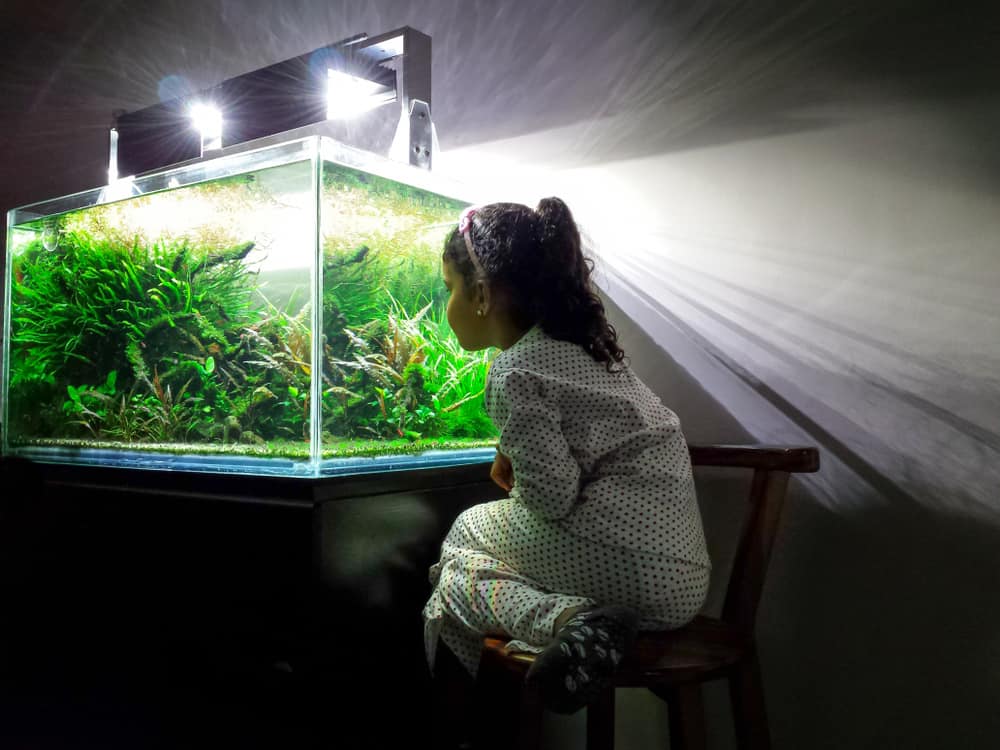
Final Thoughts
Whether you’re looking to add some greenery to your goldfish’s bowl or a pop of color in your pond, there’s a floating aquarium plant that can bring your aquascape to new heights. Floating plants offer a buffet of benefits that both you and your pets can enjoy. Take the time to find the best floating aquarium plants for your individual needs, weighing up the pros and cons in the process. Your aquatic family will thank you for it.

